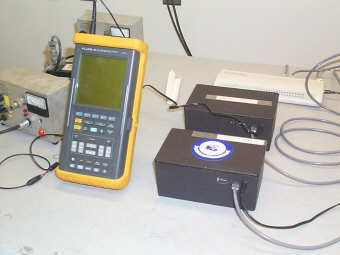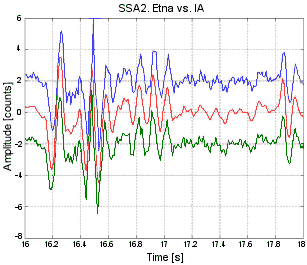Embedded LINUX in a Soft Real-Time Task:
The Canadian Geological Survey Internet Seismometer
![]()
![]() © September 2001
© September 2001
![]()
![]()
![]()
The GSC-PGC embedded LINUX Accelerometer
• Acceleration Sensors
In perspective, the Geological Survey of Canada plans to deploy a great number of strong-motion seismometers in the urban areas of Canada's seismic risk areas (2) were at the same time a well developed Internet infrastructure is already in place.
In order to take advantage of this communications infrastructure a digital strong motion seismometer was designed at the Pacific Geoscience Center and was mated with an Internet data server so that data from an instrument can be retrieved via standard Internet protocols.
Arescon ltd. in Sidney, B. C., Canada was contracted to design the data acquisition software and the communications and data server package.
Normally the instrument acquires continuous acceleration data from the three or-thogonal
sensors and stores five minute blocks in a file system which is accessible over
the Internet. This file system can hold data from about two and a half days and is per-manently
updated.
Additionally, velocity, displacement (4) and certain spectral properties (5) are continuously
calculated as well. As soon as the instrument detects a seismic signal, para-metric
data, such as peak ground acceleration, velocity and displacement together with
spectral intensity data are reported in a message send to central computer.

Figure 1: Two Internet Accelerometers in the Lab
In the hardware design,the distinction between data acquisition system and data server is somewhat artificial. An embedded computer, in the current design the Intel compatible JUMP-tech ETX/MGX single board computer, is used to perform part of a digital signal-processing chain for the data from the accelerometers as well as to provide data storage and access to data by the standard File Transfer Protocol (FTP). The computer runs under the free Open-Source operating system LINUX in a small and very specialized (embedded) version which also was designed by arescon ltd. from several different sources (see 8).
Acceleration Sensors
Most existing strong motion seismometers use electromechanical "force feedback" sensors to measure ground acceleration. While these instruments have very desirable characteristics like the coupled pendulum instrument developed by (8) for example, they are expensive due to the complex manufacturing of the electro-mechanical sensors in rather small production numbers.
With current technology it is possible to manufacture micro-machined solid-state acceleration sensors in larger quantities and a study by the U.S. Geological Survey has shown (1), that rather sensitive seismometers can be built using these sensors.

Figure 2: Comparing the Internet accelerometer (middle trace) with two different commercial instruments in a simulation of the 1992 Landers earthquake.
The accelerometer hardware, which was designed by Ken Berverley at the Pacific Geoscience Center (PGC) in Sidney, British Columbia, also employs micro machined acceleration sensors. While the sensors used here are less sensitive than the ones studied by (1), they are in turn produced in very large quantities as parts of airbag triggering devices for the car industry. They are consequently relatively cheap.
The instrument is designed to measure acceleration in three orthogonal directions. For each of the sensing directions four accelerometer chips are operated in parallel to improve overall noise performance. The current design exhibits a sensitivity of 0.5 mg (with g the earth' gravitational acceleration). For comparison: The average person senses ground acceleration from an earthquake when it reaches about 15 mg.
Recordings from a simulation of the Landers (California 1992) earthquake are shown in figure 2. We had mounted several Internet accelerometers and four commercial strong-motion seismometers (Kinemetrics Etna and SSA2) on a large shake-table when several brick wall elements were tested with respect to their earthquake resistance by the engineering group of Prof. Carlos Ventura (University of British Columbia, Dept. of Mechanical Engineering).The middle trace in figure 2 was recorded by one of the Internet accelerometers, upper and lower traces are from a Kinemetrics SSA2 and Etna strong motion seismometer respectively. The recordings compare well, differences at higher frequencies may be due to the fact that the instruments could not be mounted all in the same location on the shake-table.